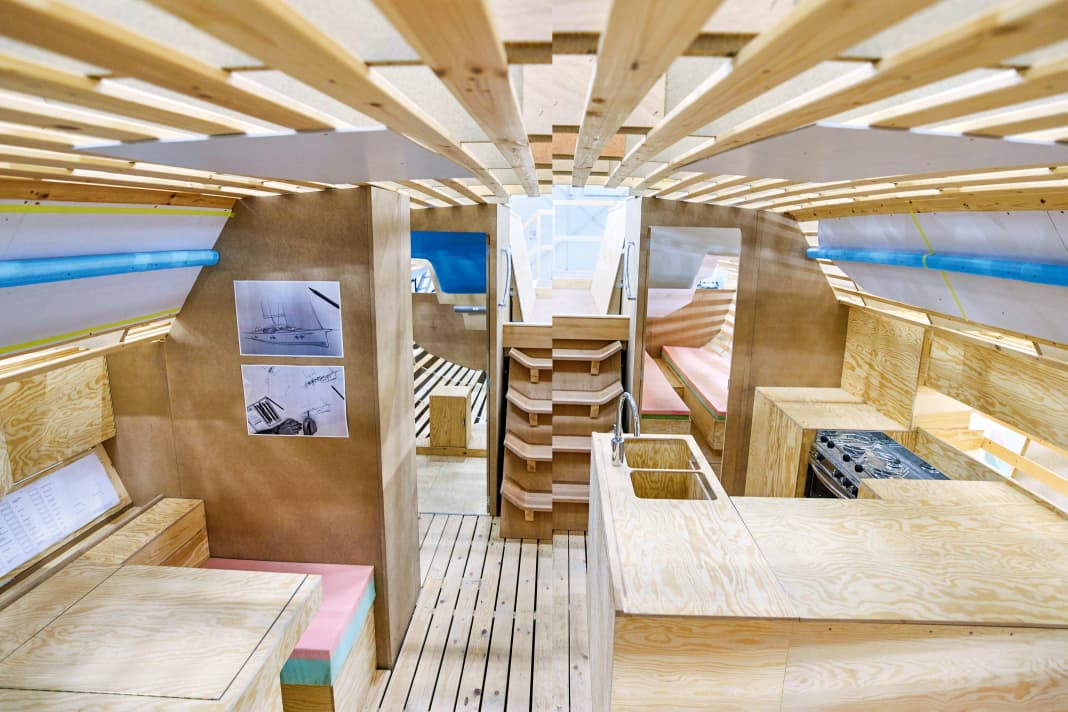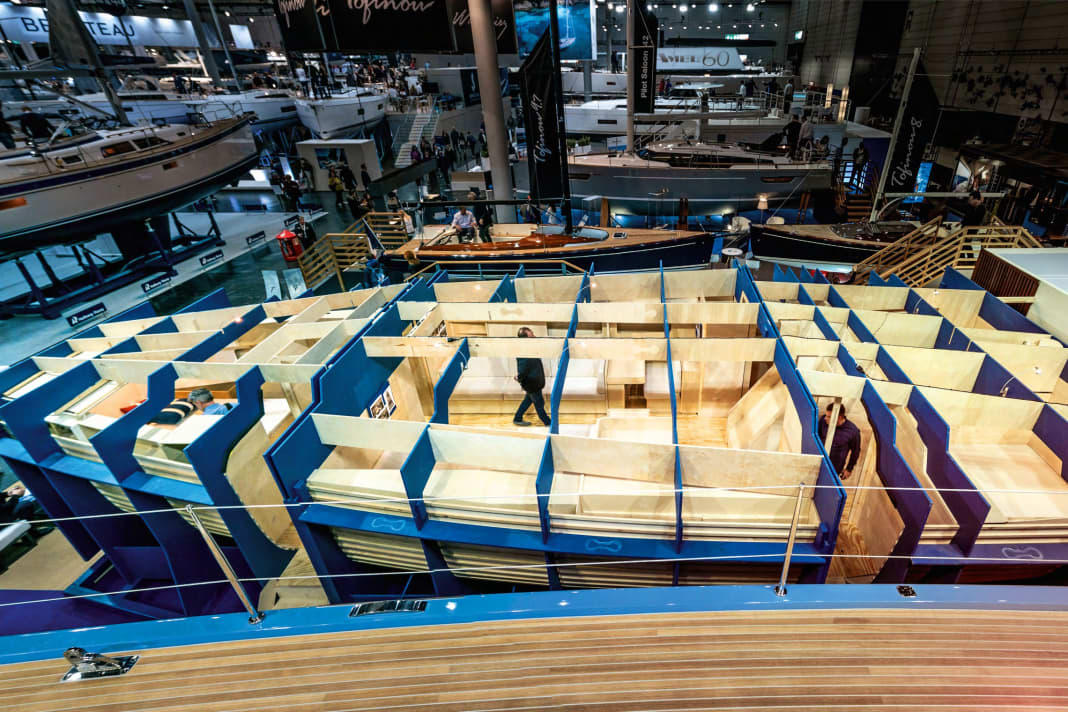





She has just celebrated her world premiere in Cannes at the Yachting Festival on the Côte d'Azur. And yet a doppelganger of her has been almost ready to go in the shipyard in Haderslev, Denmark, for more than a year. X-Yachts took a lot of time to test the proportions and functionality of the new Xc 47 on a one-to-one scale model with the double, elaborately crafted from plywood panels and pinewood mouldings.
The team around CEO Kræn B. Nielsen and Head of Development Thomas Mielec even went one step further than other high-end boatbuilding companies: they mounted the so-called mock-up, which is intended to give a realistic and true-to-scale impression of the interior, on a metal frame - and it is so stable that the entire structure can be tilted on its side by a forklift or crane as if the boat were sailing through the hall at a 20-degree angle. This has never been seen before in this form in series yacht construction.
And it's not the only simulation that X-Yachts produced using a jigsaw. In addition to the 14.30 metre long cabin dummy, the Danes also built parts of the cockpit in plywood and the entire propulsion unit aft - with the original diesel engine, generator and stern thruster behind it. An immense effort when you consider that ships today are usually created entirely in 3D design programmes on the computer, where they can be experienced for the first time before even a single mat of resin has to be soaked or a piece of wood sawn to size.
The model enables great learning effects
The shipyard remains silent about the cost of the models. But it takes little imagination to determine at least an approximate value. All in all, the blanks will correspond to the price of a ten-year-old 32-foot yacht from large-scale production, somewhere between 70,000 and 100,000 euros. A considerable additional investment. But Thomas Mielec is convinced that the construction was worth it:
We learnt more from the model than we had hoped for" (Thomas Mielec)
Kræn B. In retrospect, Nielsen is happy about the intermediate step between design and series production: "It's cheaper to change something on the mock-up than later, when the boat has been fully developed and production has already started."
In fact, modelling in plywood is now almost standard in the yacht development process. All well-known series production yards rely on it, albeit to varying degrees of detail and with differing interests. While some are primarily concerned with usability and the impression of space, manufacturers in the luxury sector even simulate colour schemes and surfaces, wall and ceiling panelling and veneers.
The models are also a marketing tool
Recently, the dummies have also increasingly taken on a kind of marketing and sales function. It is a "very interesting way" to get potential buyers excited about a new boat, says CEO Nielsen. He attributes seven orders for the Xc 47 not least to the mock-up, which was the highlight for visitors at the in-house boat show at the shipyard last November.
It was a fantastic opportunity to involve customers at an early stage" (Thomas Mielec)
Instead of just looking at computer illustrations, they were able to sit in the new ship in Haderslev and mentally embark on a long voyage. The shipyard boss is convinced that this does something to people. As soon as they are on board, they can "experience a little bit of the dream" that they want to realise with the boat later on.
One-to-one models from other shipyards






Nautor is also focussing on this. The luxury shipyard has already advertised an upcoming model twice at boot Düsseldorf with a mock-up: first with a replica of the Swan 65 that could only be seen from the outside through narrow openings, then two and a half years ago with an even more elaborate, fully accessible mock-up of the Swan 58.
In this way, active marketing not only began much earlier than if the Finns had waited for the first model to be exhibited. They also created a trade fair highlight, because such a complete plywood dummy had never been seen before. Giovanni Galgani, Head of Product Marketing, swears by the persuasive power of the blanks. He estimates their importance for sales at 40 per cent and their relevance for the fine-tuning of design and construction at roughly 60 per cent. "Even if we could only use the mock-ups internally, the effort would be worth it," he says. "Sometimes you just don't feel completely comfortable in a cabin or a wet room, even if the dimensions correspond to the comfort dimensions. You can only find that out with a one-to-one model."
Sometimes it's all about millimetres
The developer, who works closely with regular designer Germán Frers, cites the aft cabin of the Swan 55 as an example: "It looked a little cramped in its original form." The shipyard then lowered the floor by several centimetres compared to the level in the saloon. "A small measure, but one that significantly improved the impression of space," says Galgani. That's why he insists that the deck is at least half closed when producing the mock-ups, so that the plywood interior does not remain open at the top, giving a false sense of airiness.
As soon as the model is ready, the designer comes to "test live". He spends hours in there, letting everything sink in and then sketches out his changes - usually on paper, but sometimes with a saw. "We fight over every detail if something doesn't fit," says Galgani, who loves this part of the design process despite all its complexity. "It's amazing how much optimisation is possible without fundamentally throwing the design overboard." In large-scale production, larger tolerances are usually used, but at Nautor, where gaps are frowned upon, it is sometimes "really a matter of millimetres".
It is an extremely valuable development and marketing tool" (Giovanni Galgani)
If there is a choice of several interior variants, the shipyard will manufacture the options as additional modules in case of doubt. This can be a multifunctional space aft, an owner's cabin, but also customised products for the owner's individual wishes. For example, Nautor customised the shape of the ground anchor for a buyer who did not want to run the anchor under the bowsprit, but in a holder in the anchor locker, in order to save as much space as possible behind the stern. Mock-ups are also suitable for this because they ensure that everything fits in the end.
Mock-ups are used by many shipyards
Large-scale production shipyards do not go that far. But even they often use plywood simulation technology. For example, Bavaria produced a model of the interior before the launch of the Vision series - and simply placed the interior in the already laminated and reinforced mould of the hull shell. A few years ago, former Jeanneau developers Eric Stromberg and Hervé Piveteau had an angled cockpit built in their office so that they could test and optimise the functionality of the Sun Fast 3600.
World market leader Beneteau also builds a mock-up of important models before starting series production - such as the Oceanis 46.1, which is now the undisputed bestseller of its generation and class with more than 500 units sold.
At Seascape there were mock-ups for every model
Even at Seascape, which until now has not been so well known for its interior design, but mainly for its outstanding sailing performance, mock-ups are an integral part of the development process. The Slovenian shipyard, which designs and manufactures the 14 to 40-foot First models for Beneteau, has tested dummies for each of its boats.
For the First 27, for example, originally launched as the Seascape 27, the team determined whether a trailerable width of 2.54 metres would be feasible without too many restrictions in the living space below deck. The complex design of the shaft and the lowering mimicry for the outboard motor driven in the cockpit could also only be sensibly determined by modelling. For the Seascape 24, the shipyard used a mock-up to ensure that the keel box could be integrated into the interior in the best possible way. "These are questions that can neither be answered in the 3D programme with the help of virtual joint dummies nor with an animation and 3D glasses," says CEO Andraz Mihelin.
For many aspects of comfort, numbers and dimensions are sufficient, he says: "For example, bunk sizes and standing heights can be specified in the design. "But what is difficult are the spaces in between and how they are perceived. You can only really judge them on a one-to-one basis."
For the latest model, the First 36, the engineer and freethinker had more than half a dozen mock-ups built, including the entire interior, several parts of the cockpit and the bowsprit, including the anchor suspension. "In terms of the insights we gain, it's such a small investment of time and budget that we don't even think about doing it. It's a kind of reflex."
For the Seascape boss, a mockup should remain rather simple. "If it's too polished, changes become more complicated. But if it looks too raw and improvised, on the other hand, it doesn't give the right impression." The right balance is therefore required.
X-Yachts simulated all the details
Measured against this, the Xc 47 model was probably a touch too perfect. The Danes carpentered it in typical Scandinavian craftsmanship and even fitted some of the original equipment. The washbasins and toilets are made of porcelain, the oven, door handles and handrails are made of stainless steel. And although neither the substructure of the saloon table is original nor is it veneered, it matches the dimensions and functions of the standard boats in every respect: Thanks to four fold-out panels, it can be transformed from a compact couch table into a formidable dining table. Any more detailing and you could almost call it a prototype.
It is cheaper and easier to change something on the mock-up than later, when the boat has been fully developed and production has already started" (Kræn B. Nielsen)
The meticulousness with which X-Yachts has gone to work here demonstrates how important the first model in the new blue water series is for the shipyard. With it, the brand, which is enjoying great demand, is once again differentiating its product portfolio - similar to 15 years ago with the first models in the Xc line, which was created in parallel to the performance-orientated Xp series.
Today, this has thinned out considerably; the majority of sales come from the yachts of the so-called X-Pure series (X 4.0 to X 5.6), which can be used more widely. As a result, the competition from the company's own range is tougher. And there are also many external competitors in the luxury segment. It is therefore understandable that X-Yachts did not want to leave anything to chance during development. Especially as the design no longer comes from Niels Jeppesen, but from the in-house design team led by Thomas Mielec.
After the positive experience with this, X-Yachts wants to continue to focus more on mock-ups in the future. This was clear to shipyard boss Kræn B. Nielsen realised this early on. However, it is not yet clear whether they will be able to be tilted to the side. Because you have to know one thing: The experience is unsettling. In 40 years of sailing, he has never been seasick, says Nielsen - until he experienced 20 degrees on dry land. "That upsets every sense of balance."
Nevertheless, he does not want to have the mock-up, which has now served its purpose, dismantled. It is to be retained and given a permanent place in the exhibition hall - as a unique meeting room for meetings with employees and discussions with customers.

